Sea anemone
| Sea anemone | |
|---|---|
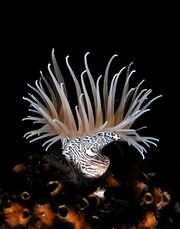 |
|
| Colonial zebra anemone from East Timor | |
| Scientific classification | |
| Kingdom: | Animalia |
| Phylum: | Cnidaria |
| Class: | Anthozoa |
| Subclass: | Hexacorallia |
| Order: | Actiniaria |
| Suborders | |
|
Endocoelantheae |
|
| Diversity | |
| 46 families | |
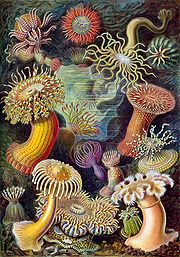
Sea anemones are a group of water dwelling, predatory animals of the order Actiniaria; they are named after the anemone, a terrestrial flower. As cnidarians, sea anemones are closely related to corals, jellyfish, tube-dwelling anemones, and Hydra.
Contents |
Anatomy
A sea anemone is a polyp attached at the bottom to the surface beneath it by an adhesive foot, called a pedal disk, with a column shaped body ending in an oral disk. Most are from 1.8 to 3 centimetres (0.71 to 1.2 in) in diameter, but anemones as small as 4 millimetres (0.16 in) or as large as nearly 2 metres (6.6 ft) are known.[1] They can have anything from a few tens of tentacles to hundreds.
A few species are pelagic, and are not attached to the bottom; instead they have a gas chamber within the pedal disc, allowing them to float upside down in the water.[2]
The mouth is in the middle of the oral disk surrounded by tentacles armed with many cnidocytes, which are cells that function as a defense and as a means to capture prey. Cnidocytes contain nematocyst, capsule-like organelles capable of everting, giving phylum Cnidaria its name.[3] The cnidae that sting are called nematocysts. Each nematocyst contains a small vesicle filled with toxins (actinoporins), an inner filament, and an external sensory hair. When the hair is touched it mechanically triggers the cell explosion, a harpoon-like structure which attaches to organisms that trigger it, and injects a dose of poison in the flesh of the aggressor or prey. This gives the anemone its characteristic sticky feeling. The sea anemone eats small fish and shrimp.
The poison is a mix of toxins, including neurotoxins, which paralyzes the prey and allows it to be moved to the mouth for digestion inside the gastrovascular cavity. Actinoporins have been reported as highly toxic to fish and crustaceans, which are the natural prey of sea anemones. In addition to their role in predation, it has been suggested that actinoporins could act, when released in water, as repellents against potential predators. Anemonefish (clownfish), small banded fish in various colors, are not affected by their host anemone's sting and shelter from predators within its tentacles.[4]
The internal anatomy of anemones is quite complex.
Digestive system
There is a gastrovascular cavity (which functions as a stomach) with a single opening to the outside which functions as both a mouth and an anus; waste and undigested matter is excreted through the mouth/anus, which can be described as an incomplete gut. The mouth is typically slit-like in shape, and bears a groove at one or both ends. The groove, termed a siphonophore, is ciliated, and helps to circulate water through the gastrovascular cavity.[2]
The mouth opens into a flattened pharynx. This consists of an in-folding of the body wall, and is therefore lined by the animal's epidermis. The pharynx typically runs for about two-thirds the length of the body before opening into the gastrovascular cavity that fills the remainder of the body.
The gastrovascular cavity itself is divided into a number of chambers by mesenteries radiating inwards from the body wall. Some of the mesenteries form complete partitions with a free edge at the base of the pharynx, to which they connect, but others reach only partway across. The mesenteries are usually found in multiples of twelve, and are symmetrically arranged around the central pharynx. They have stomach lining on both sides, separated by a thin layer of mesoglea, and includes filaments of tissue specialised for secreting digestive enzymes. In some species these filaments extend below the lower margin of the mesentery, hanging free in the gastovascular cavity as acontial filaments.[2]
Nervous system
A primitive nervous system, without centralization, coordinates the processes involved in maintaining homeostasis as well as biochemical and physical responses to various stimuli. There are no specialised sense organs.
The muscles and nerves are much simpler than those of most other animals, although more specialised than in other cnidarians, such as corals. Cells in the outer layer (epidermis) and the inner layer (gastrodermis) have microfilaments that group into contractile fibers. These fibers are not true muscles because they are not freely suspended in the body cavity as they are in more developed animals. Longitudinal fibres are found in the tentacles and oral disc, and also within the mesenteries, where they can contract the whole length of the body. Circular fibres are found in the body wall and, in some species, around the oral disc, allowing the animal to retract its tentacles into a protective sphincter.[2]
Since the anemone lacks a skeleton, the contractile cells pull against the gastrovascular cavity, which acts as a hydrostatic skeleton. The anemone stabilizes itself by shutting its mouth, which keeps the gastrovascular cavity at a constant volume, making it more rigid. Although generally sessile, sea anemones are capable of slow movements using their pedal disc, or of swimming, using either their tentacles or by flexing their body.
Life cycle
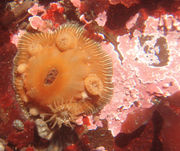
Unlike other cnidarians, anemones (and other anthozoans) entirely lack the free-swimming medusa stage of the life cycle; the polyp produces eggs and sperm, and the fertilized egg develops into a planula that develops directly into another polyp.
Anemones tend to stay in the same spot until conditions become unsuitable (prolonged dryness, for example), or a predator attacks them. In that case anemones can release themselves from the substrate and use flexing motions to swim to a new location.
The sexes in sea anemones are separate in some species, while others are protandric hermaphrodites. The gonads are strips of tissue within the mesenteries. Both sexual and asexual reproduction can occur. In sexual reproduction males release sperm to stimulate females to release eggs, and fertilization occurs. Anemones eject eggs and sperm through the mouth. The fertilized egg develops into a planula, which settles and grows into a single polyp.
Anemones can also reproduce asexually, by budding, binary fission (the polyp separates into two halves), and pedal laceration, in which small pieces of the pedal disc break off and regenerate into small anemones.
See also
- Sea anemone dermatitis
- Sea anemone neurotoxin
Gallery
 Sea anemone at Cape Arago, Oregon |
 Sea anemone in process of cloning (longitudinal fission) |
 Sea anemone at the Monterey Bay Aquarium |
Actinia equina |
 Sea anemones |
 Sea anemones, Anthopleura sola engaged in war for territory. |
 Deep–sea anemone |
 Sea anemones in a "mini-reef" marine aquarium |
 Venus flytrap sea anemone |
A shrimp living with a Beaded sea anemone |
 An Anemonefish and an Anemone |
 |
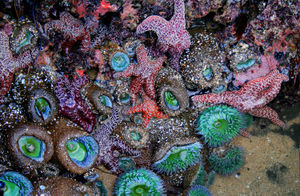 |
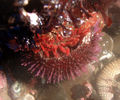 |
 |
A porcelain crab living with an anemone, probably Entamacea quadricolor |
 Colonial anemones attached to black coral from East Timor. |
 Anthopleura sola is in process of consuming a "by the wind sailor", Velella velella |
 A nudibranch, species Aeolidia papillosa starts to eat a sea anemone. |
 Hundreds of anemones at low tide - they all are clones. |
 Close-up of anemone. |
 hermit crab, Calcinus laevimanus with sea anemone |
A cluster of several small Sea Anemones growing together. |
References
External links
- Order Actiniaria
- Actiniaria.com
- Photos of various species of Sea Anemones from the Indopacific
- Anemone Armies Battle to a Standoff
- Anemone Wars: Clone armies deploy scouts, attack tidally - unsuspected military tactics
- Sea anemones look like sea flowers but they are animals of the Phylum Cnidaria
- Information about Ricordea Florida Sea anemones & pictures
- Photographic Database of Cambodian Sea Anemones